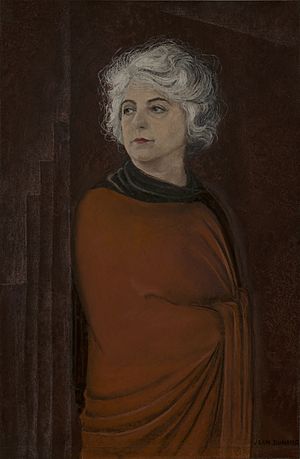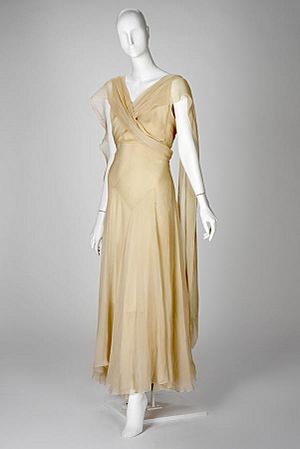Madeleine Vionnet facts for kids
Quick facts for kids
Madeleine Vionnet
|
|
|---|---|

Portrait of Madeleine Vionnet by Jean Dunand.
|
|
| Born | 22 June 1876 Chilleurs-aux-Bois
|
| Died | 2 March 1975 (aged 98) Paris
|
| Nationality | French |
| Occupation | Fashion designer |
|
Label(s)
|
Madeleine Vionnet |
Madeleine Vionnet (pronounced: [ma.də.lɛn vjɔ.ne]; June 22, 1876 – March 2, 1975) was a famous French fashion designer. She was known for her elegant dresses and for making the "bias cut" popular. This special way of cutting fabric made clothes flow beautifully.
Vionnet learned about fashion in London. She then returned to France and opened her first fashion house in Paris in 1912. It had to close in 1914 because of World War I. But after the war, she reopened it. Vionnet became one of the top designers in Paris during the 1920s and 1930s. She closed her fashion house in 1939 and retired in 1940.
People called her the "Queen of the bias cut" and "the architect among dressmakers." Her designs still inspire many modern designers today.
Contents
Madeleine Vionnet's Early Life
Madeleine Vionnet was born on June 22, 1876, in a poor family in Chilleurs-aux-Bois, Loiret, France. Her parents separated when she was very young. She moved with her father, who was a toll collector, when she was five.
Vionnet left school at age twelve. She began working as a seamstress. At 18, she had a short marriage. After that, she moved to London to work as a hospital seamstress. In London, she also worked for a designer named Kate Reily.
Becoming a Fashion Designer
Vionnet later returned to Paris. She worked for six years at the fashion house Callot Soeurs. She made "toiles," which are test versions of clothes. She learned a lot there, saying they helped her make "Rolls-Royces" instead of "Fords."
From 1907 to 1911, Vionnet designed for Jacques Doucet. Her ideas were very different from the usual styles of the time. She liked loose robes and even used models who walked barefoot.
In 1912, she started her own fashion house, "Vionnet." It closed in 1914 because of World War I.
The "Temple of Fashion"
Vionnet reopened her fashion house in 1923. She moved to a new building on Avenue Montaigne. This place became known as the "Temple of Fashion." In 1925, her business grew, and she opened a location on Fifth Avenue in New York City.
Her bias cut clothes were very popular in the 1930s. Famous actresses like Marlene Dietrich and Greta Garbo wore her beautiful gowns. Vionnet's ideas about how women's clothes should fit changed fashion forever.
She also cared a lot about her workers. She offered them paid holidays, maternity leave, day-care, a dining hall, and even a doctor and dentist. These were very new ideas for the time.
World War II forced Vionnet to close her fashion house in 1939. She retired in 1940. During her career, Vionnet created about 12,000 garments.
Vionnet's Unique Style
Vionnet was a private person. She didn't like being in the public eye. She even said she was "an enemy of fashion." She felt that fashion's quick changes were "superficial." She wanted to create timeless beauty, not just what was popular at the moment.
Designing for the Natural Body

Vionnet, like Coco Chanel, helped move fashion away from stiff, formal clothes. She wanted clothes to be soft and flowy. She famously said, "when a woman smiles, her dress must smile with her."
She did not use corsets or padding. She wanted clothes to show off a woman's natural shape. She was inspired by the dancer Isadora Duncan and ancient Greek art. Greek clothes seemed to float around the body, and Vionnet wanted her designs to do the same.
The Revolutionary Bias Cut
In the 1920s, Vionnet became famous for using the bias cut. This is a way of cutting fabric diagonally across its grain. This makes the fabric stretch and move with the body. It also helps the fabric drape beautifully.
While Vionnet didn't invent the bias cut, she was the first to use it for a whole garment. Before her, it was mostly used for small details or trims. Her use of the bias cut made clothes sleek and flattering. It changed women's fashion and made her a top designer.
Vionnet knew that fabric cut on the bias could hug a woman's curves. It also allowed for more movement and comfort. She wanted her designs to be expressive and easy to move in.
Her Design Process
Vionnet's simple-looking styles actually took a lot of work. She would cut, drape, and pin fabric designs on tiny dolls first. Then, she would create the full garments on life-size models. She used fabrics like crêpe de chine, silk, and satin. These materials were unusual for women's fashion in the 1920s and 30s.
She would order fabric that was wider than needed. This allowed for beautiful draping. Her clothes were luxurious and sensual, but also simple and modern. Some of her famous styles included the handkerchief dress, cowl neck, and halter top. These designs moved with the person wearing them.
Vionnet's Lasting Influence
Madeleine Vionnet is one of the most important fashion designers of the 20th century. Her bias cut and elegant designs still influence fashion today. Many famous designers, like John Galliano and Issey Miyake, have been inspired by her work.
Issey Miyake once said that seeing Vionnet's work felt like seeing "a woman emerging from bathing, draped only in a single piece of beautiful cloth." This shows how simple yet powerful her designs were.
Vionnet also inspired designers like Marcelle Chaumont. She was even the godmother to French author Madeleine Chapsal.
See also
 In Spanish: Madeleine Vionnet para niños
In Spanish: Madeleine Vionnet para niños







